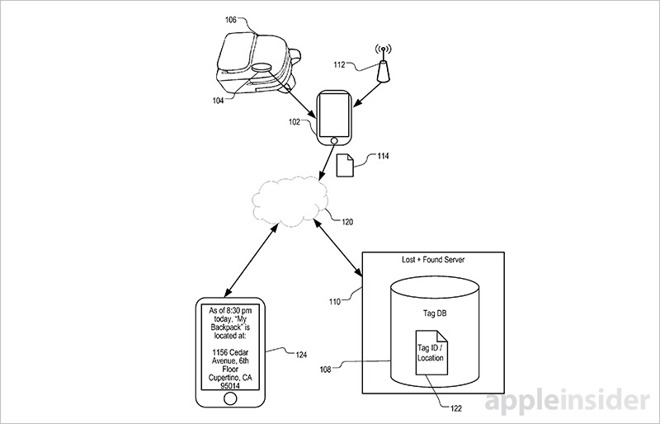Apple on Tuesday was granted a patent covering a lost-and-found system that enlists the help of other user devices to locate and track items to which low-power electronic tags are affixed.

Source: USPTO
As published by the U.S. Patent and Trademark Office, Apple's U.S. Patent No. 9,479,920 for "Power management in crowd-sourced lost-and-found service" details an invention that enlists the power of the digital community to locate commonly misplaced items, from backpacks to keys.
Similar in function to hardware/software tracker solutions like those marketed by Tile, Apple's method involves attaching electronic tags to personal belongings. The tags employ a Bluetooth Low Energy (BLE) beacon programmed to periodically transmit a locator signal to nearby devices, ideally within a range of a few meters. Broadcast signals might include custom labels, like "My backpack," to identify the attached item.
Powering the system on the ground is a dragnet of mobile devices provisioned to search for these special tags. Apple refers to the system as crowd-sourced, and considering the proximity restrictions of BLE, a large number of users would be required if the program is to be effective.
According to Apple, users may opt out of crowd-sourced lost-and-found services because of onerous power requirements. Constantly monitoring for tag pings and sending location information to the cloud are battery draining operations. To help alleviate those concerns, today's invention relies heavily on low-energy communications technology.
In some embodiments, the user registers their tag with a central lost-and-found service, which aggregates beacon identities in a database for cross-referencing incoming location information. As a crowd-sourced service, the system relies on a plurality of connected devices which use an onboard Bluetooth receiver to monitor their surroundings for tag broadcasts.
Apple offers an example in which "My backpack" is lost. If the tag is discovered, a participating mobile device can associate the event with a nearby wireless access point, assigning a location to the tag for upload to the lost-and-found server. Similar to A-GPS technology, known AP locations derived from MAC addresses can be used to deduce a rough estimation of the tag's instant position.
An alternate embodiment describes a method of collecting granular location data through onboard geolocation functions like GPS, barometer and compass readings. This feature, however, relies on power-hungry components, defeating in part Apple's plans to drive crowd-sourced cooperation.
The owner of "My backpack" can submit a location request to Apple's lost-and-found server when they realize the item is missing. Once the ticket is lodged, the system authenticates the tag owner and provides them with the most recent location estimates, if any are available.
Depending on the granularity of crowd-sourced location results, tag information might include a timestamp and latitude, longitude and altitude coordinates. Alternatively, tag data can be plotted as a marker in a mapping app, much like Apple's Find My iPhone product.
It is unclear whether Apple plans to bring electronic lost-and-found tags and the accompanying centralized service to market, though other options are already available to consumers. The aforementioned Tile, for example, comes with a feature called "Notify When Found" that is almost identical to the crowd-sourced technology described in Apple's patent.
Apple's low-energy crowd-sourced lost-and-found patent was first filed for in September 2015 and credits Robert Mayor as its inventor.


